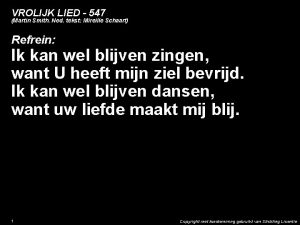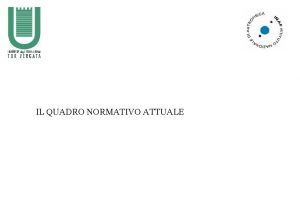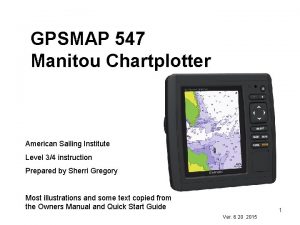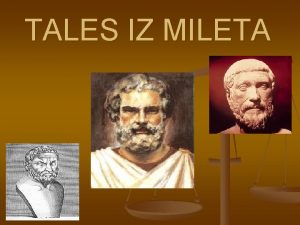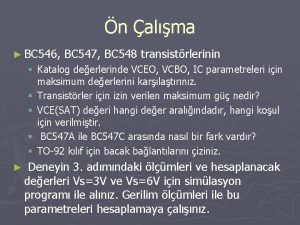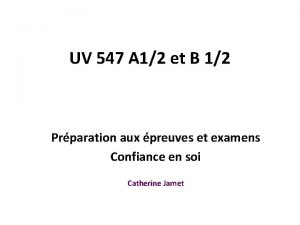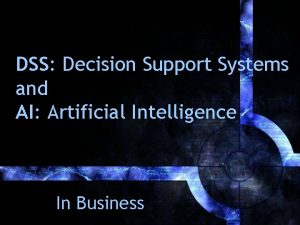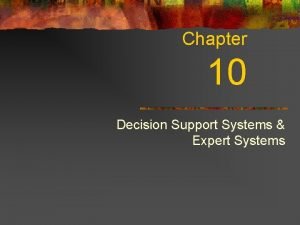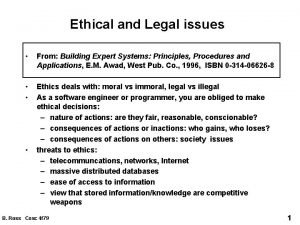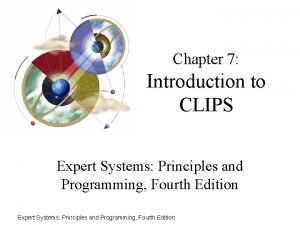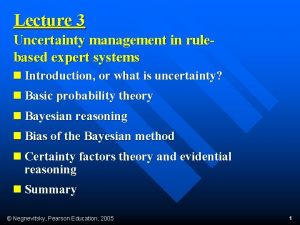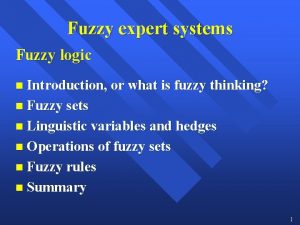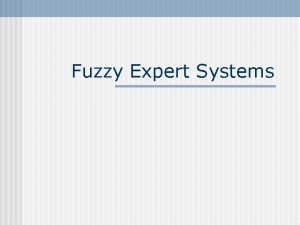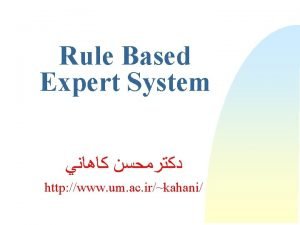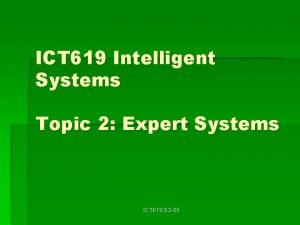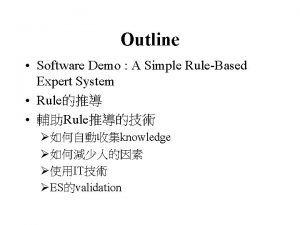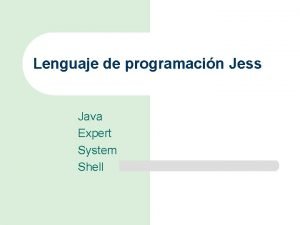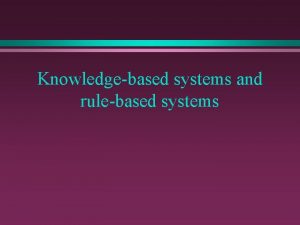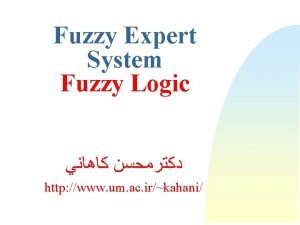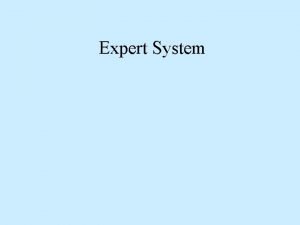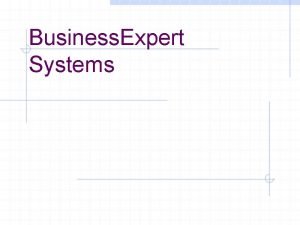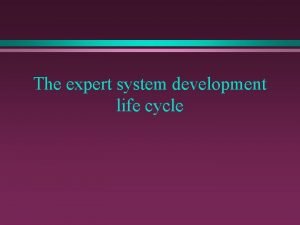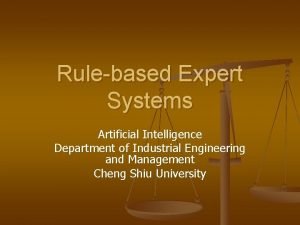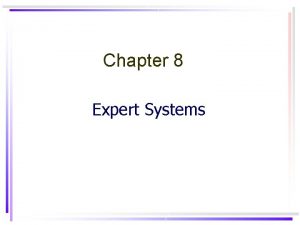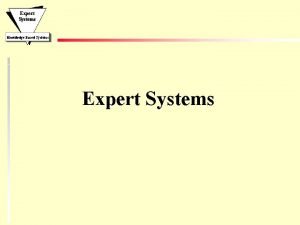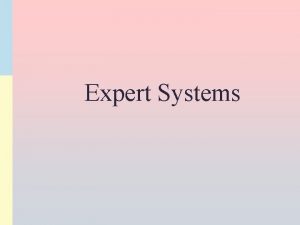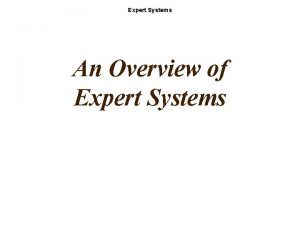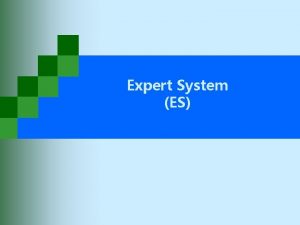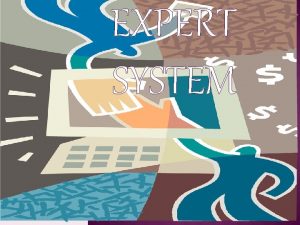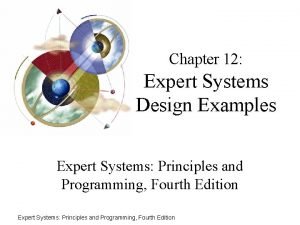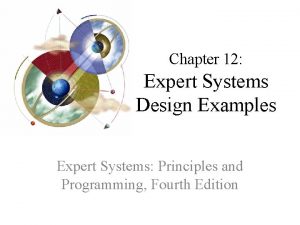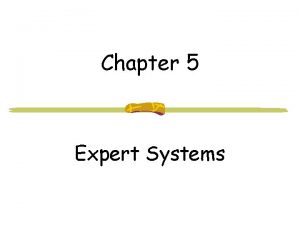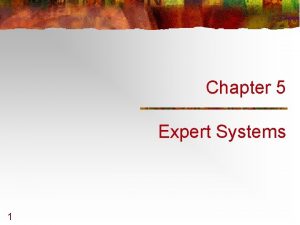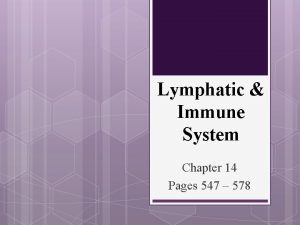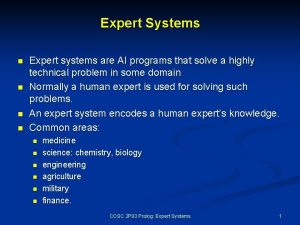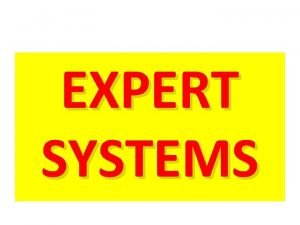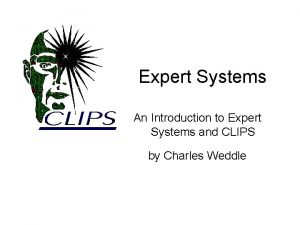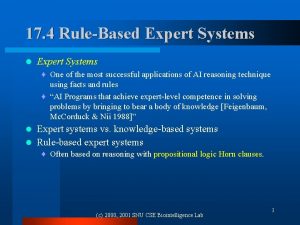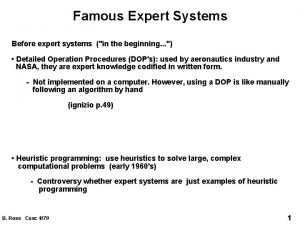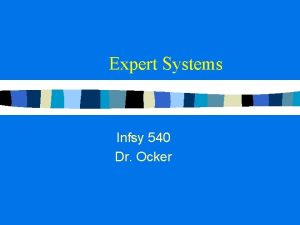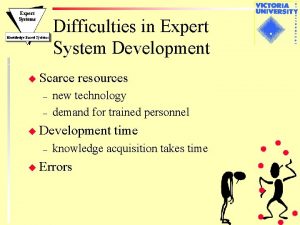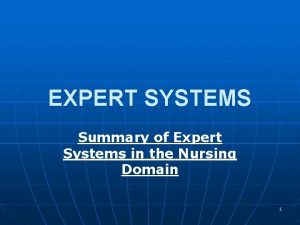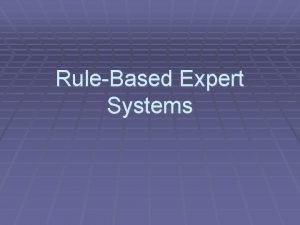Chapter 8 Expert Systems Expert System p 547






























- Slides: 30

Chapter 8 Expert Systems

Expert System p. 547 MYCIN (1976) see section 8. 2 backward chaining + certainty factor and rule-based systems p. 233 Bayesian network p. 239 Fuzzy logic p. 246 Probability and Bayes’ theorem p. 231 PROSPECTOR (1976), DENDRAL (1978) expert systems shells EMYCIN Artificial Intelligence 2 Chapter 8

Expert System using domain knowledge representation p. 297 reasoning with the knowledge, explanation Knowledge acquisition (p. 553) 1) entering knowledge 2) maintaining knowledge base consistency 3) ensuring knowledge base completeness MOLE (1988) is a knowledge acquisition system for heuristic classification problems such as diagnosing diseases. Artificial Intelligence 3 Chapter 8

Expert System problem : the number of rules may be large control structure depend on the specific characteristic of the problem ���� ) 1) Brittleness ( : no general knowledge that can be used, the data is out of date 2) Lack of meta-knowledge : the limitation of the control operation for reasoning 3) Knowledge acquisition : difficult to transform the knowledge from human to machine 4) Validation : the correctness of the knowledge in the system, no formal proof that machine is better than human or human better than machine. Artificial Intelligence 4 Chapter 8

Artificial Intelligence 5 Chapter 8

Artificial Intelligence 6 Chapter 8

Artificial Intelligence 7 Chapter 8

Artificial Intelligence 8 Chapter 8

Artificial Intelligence 9 Chapter 8

Artificial Intelligence 10 Chapter 8

Expert Systems Definition • Expert systems (ES) is a system that employs human knowledge captured in a computer to solve problems that ordinary require human expertise. • ES uses by expert as knowledgeable assistance. • Specific domain Artificial Intelligence 11 Chapter 8

Artificial Intelligence 12 Chapter 8

Artificial Intelligence 13 Chapter 8

Artificial Intelligence 14 Chapter 8

Artificial Intelligence 15 Chapter 8

Artificial Intelligence 16 Chapter 8

Artificial Intelligence 17 Chapter 8

Artificial Intelligence 18 Chapter 8

Artificial Intelligence 19 Chapter 8

Artificial Intelligence 20 Chapter 8

Artificial Intelligence 21 Chapter 8

Artificial Intelligence 22 Chapter 8

EX 05 EX 14. PRO : Guess a number predicates action(integer) clauses action(1) : - !, write("You typed 1. "). action(2) : - !, write("You typed two. "). action(3) : - !, write("Three was what you typed. "). action(_) : - !, write("I don't know that number!"). goal write("Type a number from 1 to 3: "), readreal(Choice), action(Choice). Artificial Intelligence 23 Chapter 8

Artificial Intelligence 24 Chapter 8

EX 18 EX 01. pro : Animal (cont. ) animal_is(giraffe) : - it_is(ungulate), positive(has, long_neck), positive(has, long_legs), positive(has, dark_spots). animal_is(zebra) : - it_is(ungulate), positive(has, black_stripes). animal_is(ostrich) : - it_is(bird), negative(does, fly), positive(has, long_neck), positive(has, long_legs), positive(has, black_and_white_color). animal_is(penguin) : - it_is(bird), negative(does, fly), positive(does, swim), positive(has, black_and_white_color). animal_is(albatross) : it_is(bird), positive(does, fly_well). Artificial Intelligence 25 Chapter 8

EX 18 EX 01. pro : Animal (cont. ) it_is(mammal) : - positive(has, hair). it_is(mammal) : - positive(does, give_milk). it_is(bird) : - positive(has, feathers). it_is(bird) : - positive(does, fly), positive(does, lay_eggs). it_is(carnivore) : - positive(does, eat_meat). it_is(carnivore) : -positive(has, pointed_teeth), positive(has, claws), positive(has, forward_eyes). it_is(ungulate) : - it_is(mammal), positive(has, hooves). it_is(ungulate) : - it_is(mammal), positive(does, chew_cud). positive(X, Y) : - ask(X, Y, yes). negative(X, Y) : - ask(X, Y, no). Artificial Intelligence 26 Chapter 8

EX 18 EX 01. pro : Animal (cont. ) ask(X, Y, yes) : !, write(“Question > “, X, " it ", Y, “? ”, ’ n’), readln(Reply), frontchar(Reply, 'y', _). ask(X, Y, no) : !, write(“Question > “, X, " it ", Y, “? ”, ’n’), readln(Reply), frontchar(Reply, 'n', _). clear_facts : write("nn. Please press the space bar to exitn"), readchar(_). run : animal_is(X), !, write("n. Answer. . => Your animal may be a (an) ", X), nl, clear_facts. run : write("n Answer. . => Unable to determine what"), write("your animal is. nn"), clear_facts. Artificial Intelligence 27 Chapter 8

Artificial Intelligence 28 Chapter 8

Artificial Intelligence 29 Chapter 8

The End Artificial Intelligence 30 Chapter 8
 Lied 547 tekst
Lied 547 tekst Dpr 547 55
Dpr 547 55 Gpsmap 547
Gpsmap 547 талес из милета
талес из милета Bc 547
Bc 547 547*12
547*12 Expert system in dss
Expert system in dss An expert system is
An expert system is Decision support system and expert system
Decision support system and expert system Legal expert systems
Legal expert systems Clips expert system
Clips expert system Uncertainty management in rule-based expert systems
Uncertainty management in rule-based expert systems Pxdes
Pxdes Fuzzy expert systems
Fuzzy expert systems Fuzzy expert systems
Fuzzy expert systems Rule-based expert systems
Rule-based expert systems Expert system ict
Expert system ict Expert system limited
Expert system limited Expert systems: principles and programming, fourth edition
Expert systems: principles and programming, fourth edition Dart expert system
Dart expert system Expert system demo
Expert system demo Java expert system shell
Java expert system shell Expert system architecture
Expert system architecture Jess java expert system shell download
Jess java expert system shell download Mfs
Mfs Expert system life cycle
Expert system life cycle Expert system architecture
Expert system architecture Business expert system
Business expert system Expert system development life cycle
Expert system development life cycle Expert system adalah
Expert system adalah Characteristics of expert system
Characteristics of expert system
